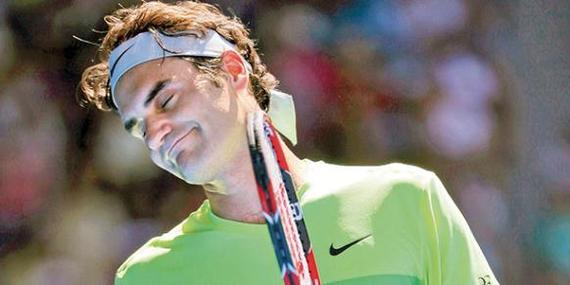At this year's Australian Open, the men's singles final will be contested between Novak Djokovic and Andy Murray, with Murray hunting his first Australian Open win and Djokovic looking to collect his fifth Australian Open (and fourth in five years).
There's nothing wrong, on the surface, with these two finalists: Murray and Djokovic are two-time and seven-time Slam champions, respectively, and have been the best two players in the tournament.
But I'm plagued by a deeper sense, before this tournament is even decided, that we are witnessing the tectonic change in the men's game that has been slowly, inexorably coming for years. And that's because of who wasn't there, at the end.
An empire, more often than not, doesn't erupt so much as erode. The "Big Four", composed of Roger Federer, Rafael Nadal, Novak Djokovic, and Andy Murray, is no longer the force of nature it once was. But it happened quietly, subtly, the way water wears away at rock.
It began in July 2003, with Roger Federer winning Wimbledon. The following season, he would claim the Australian Open and US Open. A year later, Rafael Nadal won the 2005 French Open. In 2006, Nadal began to expand his empire from the red clay of Paris, to challenge Federer on the lawns of Wimbledon. In 2007, a true threat to Federer's hard-court dominance emerged: Novak Djokovic.
In 2008, we finally had our Big Four. Djokovic broke through to win the Australian Open. Nadal snatched Wimbledon from Federer and displaced him at number one. Andy Murray ascended to contest the US Open final. The fans could only buckle up for the incredible four-way war of attrition that would define the tour's next several years.
If you look from the French Open in May 2005, when Nadal joined Federer in the Grand Slam winner's circle, to the US Open in 2013, the dominance is staggering. Thirty-five Slams played on the men's side; thirty-four claimed by the Big Four. It seemed their membership was preordained, their dominance destined: the only outsider to claim a Slam in the midst of this astonishing run was Juan Martin del Potro. Unfortunately, after del Potro knocked off Nadal and Federer back to back to snag the 2009 US Open and seemingly take a seat at the table, his body promptly quit on him. Three wrist surgeries later, he remains almost a cautionary tale: do not reach above your station.
The game belonged to the Swiss, the Spaniard, the Serb and the Scot. We got to know these players on a first-name basis, as a core cast. They were always felling waves of supporting actors until they came across one another in what rapidly became must-see TV in stadiums across the world. Roger was the elder statesman, liquid and precise, with preternatural instincts. Rafa was the warrior, the bullfighter who found joy in suffering. Novak was the interloper, with easy, lanky power. Andy was the latecomer, the genius whose relentless mind was both his greatest asset and his greatest weakness. The rivalries between these four gave us some of the greatest matches ever played.
We became acquainted with the indomitable will that burns beneath Federer's effortless grace. We embraced Nadal's humility as his savage, elemental style began to take its toll on his body. We watched Novak grow up, from upstart joker to elastic, tireless "how the hell did he hit that?" mystic. We cheered when Andy finally broke through, finally silenced his own demons and broke free of his doubts. Slam wins were no longer something difficult for anyone to do; they were expected for those four and impossible for the rest. The game was theirs, to an unprecedented level.
But in 2014, Stanislas Wawrinka bucked the title "other Swiss" and beat Djokovic and Nadal back to back to win in Australia. At that year's US Open, Marin Cilic defeated Kei Nishikori in the first Slam final that didn't feature Federer, Nadal, Djokovic or Murray since the final of the 2005 Australian Open. And here, in the 2015 edition of the Australian Open, Federer was dismissed in the third round by a journeyman and Nadal was dismantled in the quarterfinals by a man he'd previously beaten 17 times in 17 meetings. And the important detail is that neither of these things were a surprise.
We've seemingly been here before. In 2011, Djokovic defeated Murray in the Australian Open final--at the time, the first Slam final since the 2008 Australian Open that didn't feature Federer or Nadal, on the heels of three dominant seasons by the two of them. That time, Federer and Nadal roared back.
But the differences between then and now are stark: Federer is 33, visibly a step slower and continuing a gentle decline. Nadal is attempting his third comeback from season-ending injury. And, perhaps more importantly, the fortress isn't impregnable anymore. Other players dare to dream, and have come forth to win.
It's true that we often don't see the moment that something falls; we only see the moment in which we become irrevocably aware that it's gone. For me, the notion that the game's status quo was forever different was clear: I got a text from a friend currently abroad beseeching me to get out of bed and tune into the Federer-Andreas Seppi third round match. I complied, and watched as the Italian outplayed the consensus greatest men's player of all time with simple, raw belief.
He wasn't playing a member of the Big Four. He was just playing tennis. The game's chaos has returned, and the clock has finally ticked past midnight and into a new day. I don't know what's next. But amidst this sea change, amidst the sacking of the empire of the Big Four, I suspect what just ended--what we were blessed to watch--might never come again.
